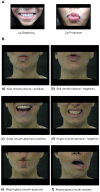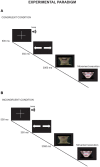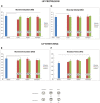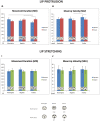The Emotional Modulation of Facial Mimicry: A Kinematic Study
- PMID: 29403408
- PMCID: PMC5778471
- DOI: 10.3389/fpsyg.2017.02339
The Emotional Modulation of Facial Mimicry: A Kinematic Study
Abstract
It is well-established that the observation of emotional facial expression induces facial mimicry responses in the observers. However, how the interaction between emotional and motor components of facial expressions can modulate the motor behavior of the perceiver is still unknown. We have developed a kinematic experiment to evaluate the effect of different oro-facial expressions on perceiver's face movements. Participants were asked to perform two movements, i.e., lip stretching and lip protrusion, in response to the observation of four meaningful (i.e., smile, angry-mouth, kiss, and spit) and two meaningless mouth gestures. All the stimuli were characterized by different motor patterns (mouth aperture or mouth closure). Response Times and kinematics parameters of the movements (amplitude, duration, and mean velocity) were recorded and analyzed. Results evidenced a dissociated effect on reaction times and movement kinematics. We found shorter reaction time when a mouth movement was preceded by the observation of a meaningful and motorically congruent oro-facial gesture, in line with facial mimicry effect. On the contrary, during execution, the perception of smile was associated with the facilitation, in terms of shorter duration and higher velocity of the incongruent movement, i.e., lip protrusion. The same effect resulted in response to kiss and spit that significantly facilitated the execution of lip stretching. We called this phenomenon facial mimicry reversal effect, intended as the overturning of the effect normally observed during facial mimicry. In general, the findings show that both motor features and types of emotional oro-facial gestures (conveying positive or negative valence) affect the kinematics of subsequent mouth movements at different levels: while congruent motor features facilitate a general motor response, motor execution could be speeded by gestures that are motorically incongruent with the observed one. Moreover, valence effect depends on the specific movement required. Results are discussed in relation to the Basic Emotion Theory and embodied cognition framework.
Keywords: basic emotion theory; embodiment; emotional valence; facial expression; facial mimicry; lip kinematics; mouth gesture.
Figures





Similar articles
-
Gesture and word analysis: the same or different processes?Neuroimage. 2015 Aug 15;117:375-85. doi: 10.1016/j.neuroimage.2015.05.080. Epub 2015 Jun 2. Neuroimage. 2015. PMID: 26044859
-
A role for affectivity in rapid facial mimicry: An electromyographic study.Soc Neurosci. 2019 Oct;14(5):608-617. doi: 10.1080/17470919.2018.1564694. Epub 2019 Jan 22. Soc Neurosci. 2019. PMID: 30669959
-
The Spatiotemporal Dynamics of Facial Movements Reveals the Left Side of a Posed Smile.Biology (Basel). 2023 Aug 23;12(9):1160. doi: 10.3390/biology12091160. Biology (Basel). 2023. PMID: 37759560 Free PMC article.
-
A neuroendocrine account of facial mimicry and its dynamic modulation.Neurosci Biobehav Rev. 2017 Jun;77:98-106. doi: 10.1016/j.neubiorev.2017.03.006. Epub 2017 Mar 18. Neurosci Biobehav Rev. 2017. PMID: 28322858 Review.
-
Facial mimicry in its social setting.Front Psychol. 2015 Aug 11;6:1122. doi: 10.3389/fpsyg.2015.01122. eCollection 2015. Front Psychol. 2015. PMID: 26321970 Free PMC article. Review.
Cited by
-
Language, Gesture, and Emotional Communication: An Embodied View of Social Interaction.Front Psychol. 2019 Sep 24;10:2063. doi: 10.3389/fpsyg.2019.02063. eCollection 2019. Front Psychol. 2019. PMID: 31607974 Free PMC article. Review.
-
Dynamic emotional expressions do not modulate responses to gestures.Acta Psychol (Amst). 2021 Jan;212:103226. doi: 10.1016/j.actpsy.2020.103226. Epub 2020 Dec 10. Acta Psychol (Amst). 2021. PMID: 33310344 Free PMC article.
References
-
- Asthana H. S., Mandal M. K. (1997). Hemiregional variations in facial expression of emotions. Br. J. Psychol. 88(Pt 3), 519–525. - PubMed
LinkOut - more resources
Full Text Sources
Other Literature Sources

